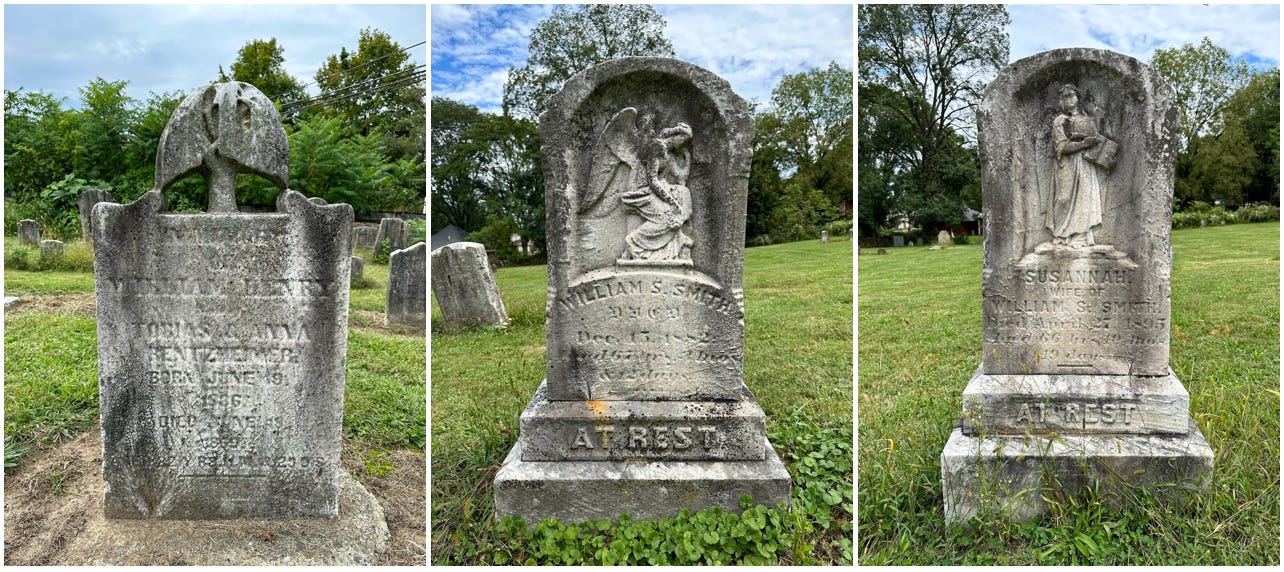Sunday Pastries With the Dead 36
The circa-1734 Old Lower Saucon Church Cemetery in Hellertown, PA.
This week’s cemetery stroll is a twofer, featuring both the old and new burial grounds surrounding a Pennsylvania church first established by German Reformed settlers in 1734.
Both the early and later cemeteries are visible when standing at certain vantage points in each, with the lovely stone building holding court between them. The first church erected here was a log cabin, which the current structure replaced in 1816.
The old cemetery across the street is situated next to what was once the area’s one-room schoolhouse; the graveyard was likely established at the same time as the congregation, around 1734.
Resonant of the area’s early settlers, there are several late-1700s-era headstones in German here—a particularly stunning set of three sandstone markers is clearly by the same carver, as evidenced by the identical lettering style and gorgeous designs on the backs, which range from floral motifs to soul effigies.
Most of the marble slab headstones are melted beyond readability, but there are a few with designs crisp enough to interpret. I love how these three markers contain combined symbology that tells a story like an illustrated page from the book of their lives (or afterlives, in this case—how very memento mori!) Dr. Ed Freeman’s 1845 stone shows a willow tree (grief and mourning), several columns (a noble life), and oak leaves (endurance, strength). Ruwina Henn Kramer’s 1847 stone also has a willow tree with a box tomb beneath it and a hand pointing up (where the soul went). Carl Weber’s 1846 stone shows an urn in the tympanum (the soul leaving the earthly body) and a willow tree behind an obelisk flanked by columns; mourning at the center memorial is an image of Weber’s wife Caroline and child Robert (Carl died at age 33 when his son was only 3 years old).
I encountered a first, here, as well—I’ve never seen a willow tree carved at the top of a headstone before, and though William Henry Rentzheimer’s 1859 stone is quite melted, it’s still spectacular. William Smith’s 1882 marker shows a weeping angel mourning the deceased; his wife Susannah’s 1895 stone displays a “recording angel” holding a book honoring the interred’s “book of life.”
I found a 1769-era marker clearly made by an amateur local carver (farmers and carpenters were often tasked with creating memorials when they were stuck indoors during the winter seasons). And these permanent “restorations” of German-language stones from 1768 and 1770 in granite and from 1772 in concrete(!!) made my heart sink…this is a masterclass in how not to preserve a historical headstone.
To end, there are a few markers of note across the street and behind the church in the circa-1852 “new” cemetery (aka the overflow from when the earlier burial ground was full). Elizabeth Koch Reiss’s 1876 stone shows hands clasped in a marital handshake, and there are two excellent examples of hip tombs here (named after the architectural roof style). And this urn-topped obelisk has some really beautiful art deco designs, as well as a base that appears to serve as a two-sided bench. A nice spot to sit and enjoy a pastry, don’t you think?
Until next Sunday, fellow taphophiles!











